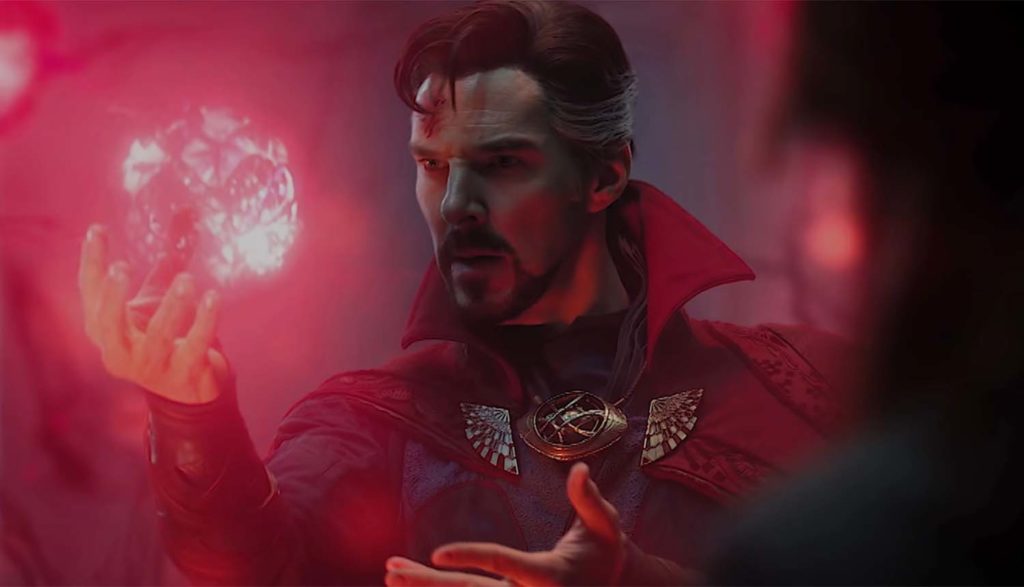
In an entirely different superhero universe, a famous villain once said, “whatever doesn’t kill you makes you stranger.”
For Doctor Strange, that’s all too true.
Steven Strange was a gifted, arrogant but pretty normal surgeon before he was in a terrible car accident. That crash pushed him into the realm of the seriously weird: He became a magic-wielding wizard, tasked with defending the planet from supernatural threats. It’s not an easy gig: In fact, he’s technically “died” myriad times for the cause, and we’re not even counting when he was snapped out of existence for a good five years (thanks to an Infinity Gauntlet-wielding Thanos in Avengers: Infinity War). But hey, all in a day’s work, right? At least he saved the universe a time or two.
But now, saving the universe just won’t be enough. Apparently, the entire multiverse might be under threat—and it all boils down to one remarkable teen girl.
The fact that there’s just one of her—just one America Chavez—is significant in itself: After all, we’re talking about a cosmos full of universes, with each one populated by variations of ourselves. In one universe, Doctor Strange might sport a ponytail. In another, he could lose his famous goatee. In others, he might never have become a wizard at all.
But as far as America knows, she’s utterly unique—the only America Chavez in the entire multiverse.
But that’s not why horrific cosmic beasties seem so intent on grabbing her. Her real gift lies in her ability to hop from one universe to another—a one-of-a-kind talent held by a one-of-a-kind person.
But there’s a problem: She can’t control this ability. She’s a little like Strange’s old pal Hulk, but with an interdimensional twist: Stress her out, and she’s liable to punch a hole straight through reality and hop into another one.
She also has a distinct lack of superhero weaponry at her disposal. She’s not super-strong. She can’t turn invisible. Outside her multiverse talents, she’s pretty normal. And that means America’s in pretty dire need of protection. Doctor Strange will do his best.
But here’s the catch: America has run into other versions of Strange that promised to protect her, too. In the end, they wanted the same thing these creatures chasing her apparently want: Her power. These Stranges wanted it for the sake of the multiverse, of course. But given that taking that power kills America, it’s still not exactly a super-heroic thing to do.
Will our Doctor Strange be any different?
[Caution: The following sections may contain spoilers.]
Doctor Strange does want to save America Chavez. And honestly, he does his very best. Better, certainly, than many other multiverse Stranges out there.
“All this for a child you just met yesterday,” someone sneers at Strange for his do-goodism. But that’s what heroes do, right?
But America’s a realist: She knows that Strange just might not be able to defeat the force arrayed against them. While previous versions of Strange have tried to take America’s power (with apologies, of course), America offers to give it to our version of Strange—even though it means her death.
She’s not the only hero here risking it all to save the multiverse. It’s what heroes do, of course.
One other interesting element to note: Wanda, a.k.a. Scarlet Witch, plays an important role here, and that role is predicated on her deep desire to be a mom. While the choices she makes here are often deeply problematic, that underlying love for her kids (or the notion of her kids—it gets a little confusing) can’t be shrugged off completely. Indeed, throughout the film, we see plenty of evidence of the power of love—even if that love is corrupted and twisted in dangerous ways.
Bring Doctor Strange and the Scarlet Witch together in a film, and you know what you get? Magic. Lots and lots of magic. And we’re not talking Lord-of-the-Rings style spells, either. The magic we see in this film feels as dark and occultic as anything we’ve seen in the Marvel Cinematic Universe.
The Multiverse of Madness draws a distinction between the sorcery Doctor Strange uses and the witchcraft practiced by Wanda. But both can apparently use the same sort of spell books, two of which play a huge role in the film. We see both cast a dizzying number of spells.
There’s a good spell book out there that gives good guys “whatever they need” to fight the evil they’re facing. But we don’t see nearly as much of that special tome as we do its evil twin tome, the Darkhold, a grimoire apparently written by an ancient demon. The book corrupts those who attempt to use it, and we see a few corrupted individuals. Using it is dangerous in other ways, too. One practitioner tells a friend to guard his body as he uses it, lest the “souls of the damned” seek to punish him.
Speaking of those souls, we see them in action: They’re skeletal beings that indeed seek to drag people to netherworlds beyond. A massive, secret shrine holds demonic spells as well (and is guarded by gigantic beings also referred to as demons). That shrine includes a relief that pays homage to a prophesied god-like ruler of the multiverse. It also seems to hold an altar of sorts, to which someone is magically chained. While it’s not referred to as a sacrifice as such, the scene’s whole vibe sure feels like some sort of blood-and-power offering to a dark deity.
A wedding takes place in a church, though the ceremony is attended by people of many faiths. (We see a woman wearing an Islamic hair covering and a Sikh wearing the faith’s characteristic Dastar.) A character sprouts a third eye in the middle of his forehead. A symbolic third eye—representing enlightenment—is a part of both Hinduism and Buddhism. A book that counters the Darkhold also exists, and its user allegedly receives whatever is needed to defeat whatever evil is being faced.
Doctor Strange attends the wedding of his former love interest, Christine. We learn that Strange and Christine have always been an item throughout their various multiverses, though these relationships (as far as we can see) always wind up in heartbreak. Our version of Strange is still clearly in love with the woman, and he says as much.
In the comics, America Chavez was lesbian. And while this movie doesn’t make reference to America’s sexual leanings, we do briefly see and hear about America’s two mothers (also part of the original comics).
We see Strange shirtless in a scene or two. Some female characters wear form-fitting outfits.
We expect superhero movies to be violent. It’s really part of the genre’s DNA. But Multiverse of Madness seems to ratchet up both the death and the gore we see and hear about.
One character magically loses his mouth, which somehow causes his head to grotesquely implode. Another character is sliced right through the midsection: We don’t see what cuts the hero in half, but there’s little question, from the bloody weapon lodged in a wall beyond, of what has happened. Yet another character is magically (if bloodlessly) shredded. Necks are snapped. Bodies are sliced. Someone’s crushed underneath a statue, while someone else is vaporized by a single word. People are battered and thrown about. At least one person dies and is then re-animated—face decaying and disfigured, fingers grotesquely bent.
Dozens of people are killed during a chaotic battle—some reduced to smoking, charred corpses. Monsters suffer a massive amount of damage, too: One—basically a giant eye and a mass of tentacles—has his appendages sliced off and his eye grotesquely plucked out. Another is skewered through the chin with a blade. Musical notes become weapons in a surreal battle.
In all the chaos, there’s no question that countless civilians are killed or injured (though the movie does not pause to consider such things), and we learn that an entire universe was obliterated through the use of the Darkhold. Universes that are colliding (and thus in danger of being annihilated themselves) sport war-like landscapes. Strange makes someone punch himself repeatedly. (When Strange walks away from the man, he tells America he’ll keep it up for three weeks.)
Three s-words sully the script. We also hear “a–,” “crap,” “d—n” and “h—.” There’s one use of the conjunction “g-dd–n.”
Strange drinks a martini at Christine’s wedding.
Doctor Strange has always been a complicated superhero, one for whom the ends seem to justify the means. Here, he uses a weapon of unimaginable darkness to combat the multiverse’s prime enemy.
Someone asks whether Spider-Man shoots webbing “out of his butt.”
The latest Doctor Strange movie is a strange movie indeed. It begins with a fever dream of a battle in some sort of extra-universal space—half platforming gaming environment, half kaleidoscope. It ladles out enough cameos and Easter eggs and “What If?” scenarios to please the most ardent Marvel fanboy. The film catapults from action to action, battle to battle with barely a breath. If we were just grading this film for creative visual effects, we’d give it an A.
But the makers seemed to be so preoccupied with how this movie looks that they lost sight of how it feels. And honestly, it feels … pretty grim.
Director Sam Raimi is probably best known for the Tobey Maguire Spider-Man movies, but he made his name as a horror auteur. And The Multiverse of Madness often feels more Evil Dead than it does your friendly neighborhood Spider-Man. Forget Spidey’s motto, with great power comes great responsibility. Raimi used his movie-making power to give us one of Marvel’s darkest superhero stories yet.
The film’s magic feels just one step away from a Ouija board. The movie itself takes some characters and twists them out of shape. It seems to take pleasure in killing off well-meaning superheroes. And while the film does offer a few heroic turns and a salient point or two, they’re almost lost in the movie’s crushing sense of self. In spite of all its color, this Doctor Strange flick is emotionally bleak and spiritually dark. It’s as if the film itself made a bargain with its own Darkhold: In exchange for a bunch of colorful eye candy, The Multiverse of Madness lost its soul.
This is hard for me to write. I’m a superhero fan, and I think that, from Iron Man to Avengers: Endgame, the Marvel Cinematic Universe gave us an epoch for the ages.
Alas, Doctor Strange in the Multiverse of Madness does not, in my opinion, bode well for the ongoing MCU. I’d like to see more great stories in one universe—not dispiriting ones in several.


Paul Asay has been part of the Plugged In staff since 2007, watching and reviewing roughly 15 quintillion movies and television shows. He’s written for a number of other publications, too, including Time, The Washington Post and Christianity Today. The author of several books, Paul loves to find spirituality in unexpected places, including popular entertainment, and he loves all things superhero. His vices include James Bond films, Mountain Dew and terrible B-grade movies. He’s married, has two children and a neurotic dog, runs marathons on occasion and hopes to someday own his own tuxedo. Feel free to follow him on Twitter @AsayPaul.